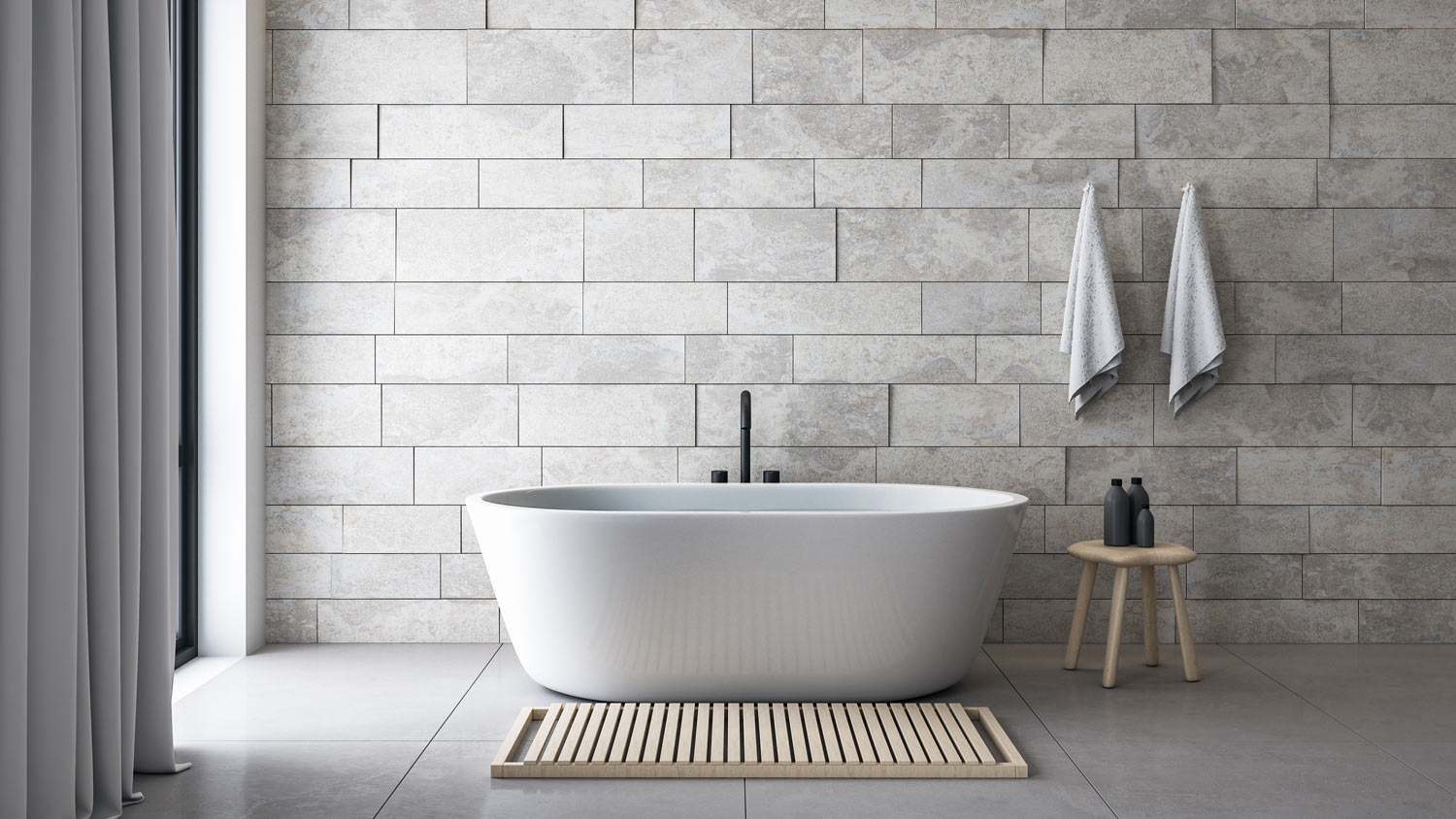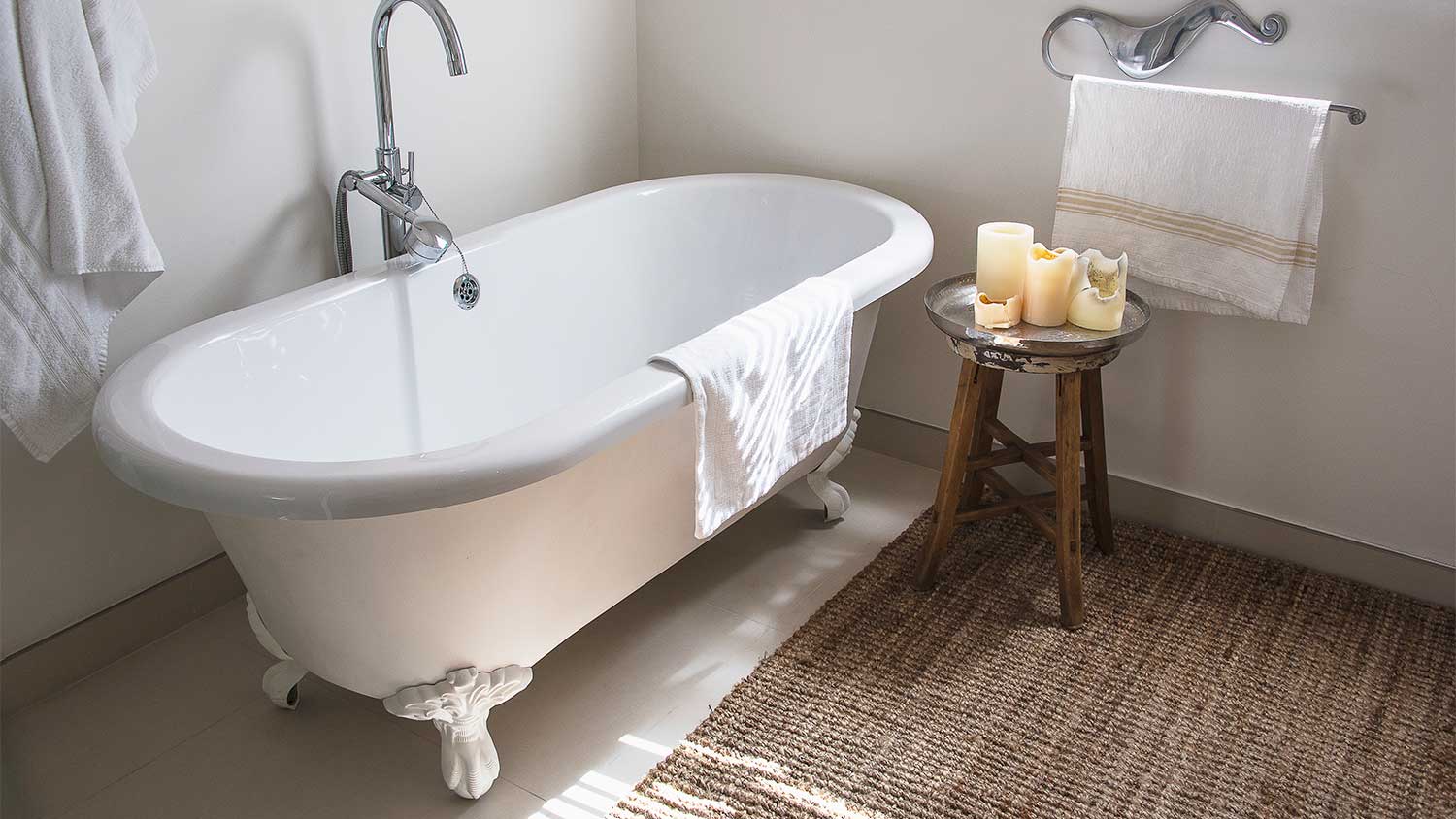
Remodeling your bathroom can add significant value to your home. Your bathroom remodel cost in Columbus, OH will depend on size, fixtures, materials, labor, and other factors.
Busy life? Let the stress melt away in your new soaker tub


A soaker tub allows for a deeper bath experience for full submersion.
Its measurements are longer, wider, and deeper to hold more water.
Some models of soaker tubs cost more than traditional designs.
A soaker tub can elevate the design of your bathroom if you have enough space to accommodate it.
Bathtime is making a comeback, and the timing is no great surprise. With comfort-focused home renovations skyrocketing, the idea of a long, luxurious bubble bath became pretty appealing. But what, exactly, is a soaker tub, and how does it compare to the traditional model? Here’s everything you need to know if you’re thinking about upgrading to a soaker tub.
A soaker tub—also known as a soaking tub—is exactly as it sounds: a luxuriously deep bathtub that allows you to fully submerge in the water. In other words, you don't have to awkwardly swivel your chilly knees to keep them warm. You'll find both freestanding soaker tub models as well as those set within a traditional shower-tub combo.
While deep tubs have existed for over a century, soaking tubs—particularly freestanding ones—have made a comeback in the past several years. Since a larger bathroom is needed to accommodate the standalone design, it's not only a comfort item but also a symbol of luxury and style. For this reason, you may see these spa-like additions popping up in real estate posts.
Soaker tubs are usually 60 to 72 inches long, although they can be as small as 54 or as big as 90 inches. The width ranges between 19 and 76 inches. The extra space allows you total comfort during a nice, long bath.
Soaker tub depths average 23 inches, compared to standard bathtub sizes that are 15 to 19 inches deep. Depending on what you’re looking for, you can find tubs that are as deep as 36 inches.
The depth of the tub is what really allows you to sink into the water for that relaxing bath you’re looking for. A soaker tub holds 200 to 250 gallons of water, while regular tubs hold around 100 gallons.
There are different bathtub materials, each with its pros and cons. Check out your options and figure out which one would work best for you.
Acrylic soaker tubs are the most commonly available. It’s a great option because acrylic is lightweight, retains heat well, and is easy to maintain. This tub type is also the most budget-friendly with plenty of sizing and shape options for you to choose from. You can expect your acrylic soaker tub to last 10 to 15 years.
Cast iron is extremely durable and retains heat very well, making it a great choice for your soaker tub. However, it’s also incredibly heavy, which you can imagine knowing how heavy a cast iron pan can be.
Make sure that your flooring is durable enough to handle the weight of the tub and water once it’s filled up, and you’ll definitely want to hire bathtub installers near you to handle the project. But once it’s installed, it’ll last a lifetime.
Wood soaker tubs have a unique appearance and can smell good when used, depending on the wood type. They also retain heat well and last about 20 years or longer. If you choose this type, prepare for a strict maintenance schedule. This includes filling the wood tub weekly, cleaning it with nonabrasive cleaners, and shielding it from direct sunlight.

Once you decide on the material for your tub, you’ll need to think about the type of soaking tub that’ll work best for your home. For bathroom remodels you’ll want to consider the space of your existing tub. That’ll help you decide if an alcove, freestanding, corner, drop-in, or undermount tub is the best bet.
If you’re building your bathroom from scratch, then you’re only limited by your imagination.
Here are the main types of bathtubs available for you to choose from:
Alcove: This three-walled design fits between bathroom walls and is perfect for shower-tub combos. It’s one of the most common and space-efficient options with a finished front panel facing the interior of the bathroom.
Freestanding: Standing independently from walls, these statement tubs become the focal point of your bathroom. However, they require more floor space than built-in options and you might need to hire a plumber to adjust your plumbing.
Corner: These triangular tubs fit into bathroom corners to maximize space, and they can work well for smaller bathrooms with awkward layouts.
Drop-In: These tubs are installed into a prepared deck or platform with the rim sitting on top for a clean, built-in look.
Undermount: This type of tub is similar to drop-in tubs, but it’s installed beneath a deck cutout. The deck edge covers the tub’s rim for a more elegant look.
Jetted: These bathtubs come with water or air jets for a luxurious experience and massage as you soak.
Walk-In: These tubs make a bathroom more accessible and feature a watertight door that allows step-in access without having to clear the side wall of a traditional tub.
One- or Two-Piece: One-piece units combine the tub and walls in a single unit for easy cleaning. Two-piece versions separate the tub from the surround for easier installation in tight spaces.
Let's put the two main types of tubs side-by-side. Sure, the size is the major difference, but factors like price, use, and bathroom requirements also play a role.
Soaker tubs are deeper, longer, and wider than most regular tubs
Soaker tubs hold up to 250 gallons, while regular ones hold up to 42
Soaker tubs are more expensive than traditional tubs
Soaker tubs do not typically have jets but do on occasion
You are more likely to find freestanding soaker tubs, unlike the traditional shower-and-tub traditional combination
Soaker tubs are more ideal for adults due to their depth
Soaker tubs are more often associated with relaxation and lounging than simple bathing
There are some key differences between Japanese soaker tubs and standard ones. The Japanese soakers are taller and can be as much as 36” deep. This depth allows you to sit down while bathing (and yes, there’s a seat inside the tub). Also, there are steps for the taller tubs for easy entry and exit.
The water reaches your chest or shoulders, and depending on your preferences, you may find this more comfortable than lying on your back.
Japanese soakers are also usually oval or square and take up less space than standard ones.
Soaking tubs cost an average of $6,800. Simple acrylic tubs can be found for as low as $600, while unique materials like wood, glass, or stone could cost over $13,000. In comparison, traditional tubs can cost as low as $2,000.
The total bathtub replacement costs—which include removing your old tub, waterproofing the surrounding area, and installing the new design—average $6,000. The final price will also come down to whether your soaker tub is part of a larger bathroom remodel, such as upgrading your tiles, fixtures, or shower doors. To get started, you'll want to find an excellent remodeling contractor with experience in bathroom design.
Choosing the best bathtub for your home is not just about fulfilling your bubble-bath-and-room-full-of-candles daydream, though that is a huge part of it. A bathtub is one of the largest items in your bathroom renovation, both when it comes to physical size and price. It should go without saying that the investment is best for someone who enjoys a long soak in the tub after a long day.
Here are some tips for choosing the best bathtub. For one, consider if a soaker tub is worth the extra investment when creating a budget for bathroom remodel costs. It seems that freestanding tubs are here to stay when it comes to bathroom trends. And spa-like features are a major focus in the National Kitchen and Bath Association's trend report for 2021. Soaker tubs fall into both of these categories, making them a great addition to your current home or a home you're about to sell.
The biggest deterrent to a soaker tub is space. You will need more room for a longer, wider, and deeper tub, especially if you buy a freestanding model. A tub should streamline the layout of your bathroom, so be sure you have space to get in and out of it safely.
Also, keep in mind that soaker tubs require more hot water—so expect a higher water and heating bill if you plan to take a nightly dip.
If a soaker tub is calling your name, consider all the great bathroom remodel ideas and then work with a bathtub replacement team near you. Replacing a traditional tub with a soaking or freestanding model requires an experienced eye and a designer who can transform your bubble-bath vision into a reality.
From average costs to expert advice, get all the answers you need to get your job done.

Remodeling your bathroom can add significant value to your home. Your bathroom remodel cost in Columbus, OH will depend on size, fixtures, materials, labor, and other factors.

If your bathroom needs sprucing up, a new vanity will make a big difference. Vanity installation costs depend on the size and type of the countertops and fixtures you choose.

Finishing an attic can make a great addition to your home. This guide breaks down the cost to finish an attic, including labor, materials, and more.

Adding kitchen cabinets to your ceiling is a budget-friendly way to increase your storage space and make your kitchen look more attractive.

An updated bathtub can give a bathroom a whole new look. Find out how much it costs to replace a bathtub in Seattle, WA, including prices by type and labor costs.

Replacing or installing an attic ladder provides a safe way to access your attic. Learn what factors affect attic ladder installation cost to help you budget.